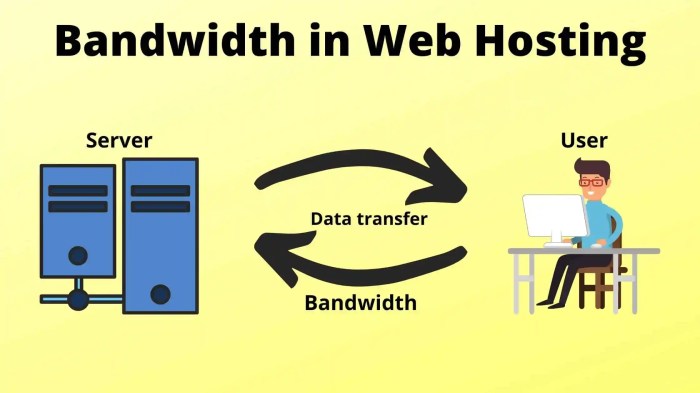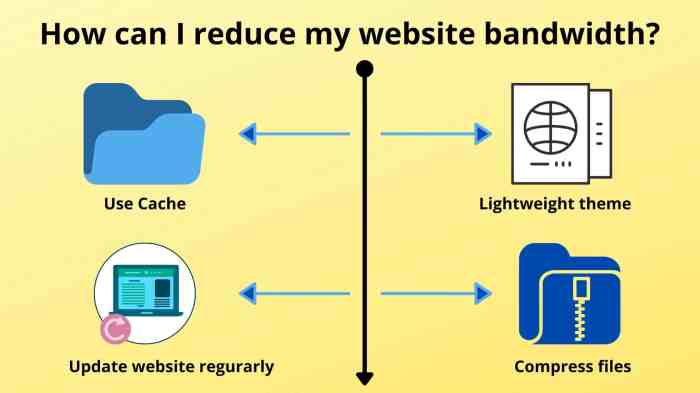The Role of Bandwidth and Storage in Web Hosting Performance is a crucial factor in determining the success of any website. Bandwidth, the amount of data that can be transferred per unit of time, dictates how quickly your website loads for visitors. Storage, on the other hand, refers to the space allocated to your website’s files, databases, and other content.
Together, these elements create a seamless and enjoyable user experience, impacting everything from website speed and responsiveness to the ability to handle traffic surges.
Imagine a website as a bustling city. Bandwidth is the highway system, allowing information to flow smoothly between your website and visitors’ devices. Storage is the city’s infrastructure, housing all the data and resources that make up the website. A well-designed city with efficient highways and ample storage can accommodate growth and thrive. Similarly, a website with sufficient bandwidth and storage can handle increasing traffic, load quickly, and provide a positive user experience.
Understanding Bandwidth and Storage
Bandwidth and storage are two crucial aspects of web hosting that significantly impact website performance and user experience. Understanding their roles and how they interact is essential for optimizing website speed and ensuring a smooth browsing experience for visitors.
Bandwidth in Web Hosting
Bandwidth refers to the amount of data that can be transferred between your website and visitors’ devices within a specific time frame. It’s like a highway that allows data to flow quickly and efficiently. Bandwidth is crucial for website performance as it directly affects how quickly web pages load. When a user requests a web page, their browser downloads the necessary data from your website’s server.
The faster the data transfer, the faster the page loads.
Types of Bandwidth
Different types of bandwidth are available, each with its own characteristics and implications for website speed:
- Shared Bandwidth: In shared hosting, multiple websites share a single bandwidth allocation. This means that the available bandwidth is divided among all websites on the server, which can lead to slower loading times if one website experiences a surge in traffic.
- Dedicated Bandwidth: Dedicated bandwidth provides a fixed amount of bandwidth specifically for your website. This ensures that your website has a consistent and predictable speed, even during peak traffic hours.
- Unmetered Bandwidth: Unmetered bandwidth plans offer unlimited data transfer, meaning you don’t have to worry about exceeding a data limit. However, it’s important to note that even with unmetered bandwidth, the speed of your website can still be affected by factors such as server load and website optimization.
Storage Capacity
Storage capacity refers to the amount of space available on your website’s server to store files, such as website content, images, videos, and databases. Storage capacity directly affects website loading times as larger files require more time to download. A website with a large amount of high-resolution images or videos will require more storage space, which can potentially lead to slower loading times if the server is not equipped to handle the demand.
Relationship Between Bandwidth and Storage
Bandwidth and storage are interconnected in web hosting. While bandwidth focuses on the speed of data transfer, storage capacity affects the amount of data that needs to be transferred.For example, a website with a large amount of high-resolution images will require more storage space. When a user requests a page with these images, the server needs to transfer a larger amount of data, which puts more pressure on bandwidth.
If the bandwidth is insufficient, the images may load slowly, leading to a negative user experience.Therefore, it’s crucial to choose a web hosting plan that offers sufficient bandwidth and storage capacity based on your website’s specific needs and expected traffic levels.
Bandwidth’s Role in Website Performance

Bandwidth is a crucial factor influencing the speed and responsiveness of a website. It determines the amount of data that can be transferred between a website’s server and visitors’ browsers within a specific timeframe. This data transfer rate significantly impacts how quickly users can access website content, such as images, videos, and text.
Impact of Different Bandwidth Levels on Website Performance
The amount of bandwidth a website has directly affects its performance. Higher bandwidth allows for faster data transfer, resulting in a smoother and more enjoyable user experience. Conversely, limited bandwidth can lead to slow loading times, frustrating users and potentially driving them away.
- High Bandwidth: Websites with ample bandwidth can handle a large volume of traffic without experiencing significant slowdowns. This ensures a consistent and fast loading experience for users, even during peak traffic hours. For instance, popular e-commerce websites with high traffic volumes require substantial bandwidth to maintain their performance and prevent website crashes.
- Medium Bandwidth: Websites with moderate bandwidth levels can accommodate a reasonable amount of traffic without major issues. This is suitable for websites with moderate user activity, such as blogs, small businesses, or personal websites. However, they may experience slight slowdowns during peak hours if traffic surges.
- Low Bandwidth: Websites with limited bandwidth struggle to handle even moderate traffic. This can result in slow loading times, especially for users accessing the website from geographically distant locations. Users may experience delays in accessing content, such as images and videos, or even encounter error messages.
Examples of Insufficient Bandwidth Leading to Slow Loading Times, The Role of Bandwidth and Storage in Web Hosting Performance
Insufficient bandwidth can have several detrimental effects on website performance, leading to a poor user experience:
- Slow Page Load Times: When a website lacks sufficient bandwidth, it can struggle to deliver content to visitors quickly. This results in slow page load times, frustrating users who may abandon the website before it fully loads.
- Lagging Videos and Streaming: Websites that stream videos or host multimedia content require ample bandwidth to ensure smooth playback. Insufficient bandwidth can lead to buffering, pixelation, and choppy playback, significantly impacting the user experience.
- Website Unresponsiveness: In extreme cases, insufficient bandwidth can lead to a website becoming unresponsive. This happens when the server is overwhelmed with requests and cannot process them quickly enough. Users may encounter error messages or be unable to access the website entirely.
Relationship Between Bandwidth and Website Traffic Volume
The relationship between bandwidth and website traffic volume is directly proportional. As website traffic increases, the demand for bandwidth also increases. This is because more users accessing the website simultaneously require more data to be transferred between the server and their browsers.
For example, a website with 100 visitors per day might only require a small amount of bandwidth. However, if the website suddenly experiences a surge in traffic to 1,000 visitors per day, the bandwidth requirements will increase significantly.
Websites need to anticipate future traffic growth and choose a hosting plan with sufficient bandwidth to accommodate it. Failure to do so can lead to performance issues and a negative user experience.
Storage’s Influence on Website Performance

Website storage is the foundation upon which your online presence is built. It’s where all your website files, databases, and other crucial data reside. The type and capacity of your storage directly impact how quickly your website loads, how smoothly it handles traffic, and ultimately, the user experience.
The Impact of Storage Capacity on Website Loading Times
Storage capacity plays a critical role in website loading times. A website with limited storage space may experience slow loading times, especially if it contains a large number of files, images, or videos. This can lead to frustrated users who may abandon your site before it fully loads. Conversely, a website with ample storage can accommodate larger files and more content, contributing to faster loading times and a better user experience.
The Role of Storage in Website Traffic and Database Operations
Storage is essential for handling website traffic and database operations. When a user visits your website, the server retrieves the necessary files from storage to display the content. Websites with limited storage may struggle to handle peak traffic, leading to slow loading times or even website crashes. Database operations, such as storing user data, managing transactions, and processing queries, also rely heavily on storage.
Adequate storage capacity ensures that these operations run smoothly and efficiently, preventing performance bottlenecks.
The Impact of Different Storage Types on Website Performance
The type of storage used can significantly affect website performance. Here’s a table outlining the key differences between two common storage types, SSDs (Solid State Drives) and HDDs (Hard Disk Drives):
| Feature | SSD | HDD |
|---|---|---|
| Speed | Faster read/write speeds | Slower read/write speeds |
| Reliability | More reliable due to lack of moving parts | Less reliable due to moving parts |
| Power Consumption | Lower power consumption | Higher power consumption |
| Price | Generally more expensive | Generally less expensive |
SSDs offer significantly faster read and write speeds compared to HDDs, making them ideal for websites that require quick loading times and responsive performance.
The Consequences of Insufficient Storage
Insufficient storage can lead to several issues, including:
- Website Crashes: When storage space is exhausted, the server may be unable to process requests, leading to website crashes. This can result in lost revenue and damage to your brand reputation.
- Slow Loading Times: Limited storage can cause slow loading times, frustrating users and potentially leading to higher bounce rates.
- Data Loss: Insufficient storage may force you to delete valuable data to free up space. This can lead to data loss and potential legal issues if you’re dealing with sensitive information.
It’s crucial to choose a web hosting plan that provides sufficient storage for your website’s needs. Consider the amount of content you plan to host, the expected traffic volume, and the size of your database.
Balancing Bandwidth and Storage for Optimal Performance
Achieving optimal website performance requires a delicate balance between bandwidth and storage. While sufficient bandwidth ensures fast loading times, adequate storage capacity allows for smooth content delivery and efficient resource management. Striking this balance is crucial for a seamless user experience and overall website success.
Ideal Bandwidth and Storage Requirements
Choosing the right hosting plan involves carefully considering your website’s specific needs. Understanding the ideal bandwidth and storage requirements for different website types can help you make an informed decision.
| Website Type | Bandwidth | Storage |
|---|---|---|
| Blog | 1-5 GB/month | 1-10 GB |
| E-commerce | 5-50 GB/month | 10-100 GB |
| Streaming | 50 GB/month and above | 100 GB and above |
Choosing the Right Hosting Plan
Selecting a hosting plan that aligns with your website’s needs is crucial for optimal performance. Over-provisioning can lead to unnecessary expenses, while under-provisioning can result in slow loading times and a poor user experience.
Consequences of Over-provisioning and Under-provisioning
Over-provisioning, while seemingly beneficial, can result in wasted resources and unnecessary costs. Conversely, under-provisioning can lead to slow loading times, website crashes, and a decline in user engagement.
Optimizing Bandwidth and Storage Utilization
Optimizing bandwidth and storage utilization is essential for maximizing website performance. Several strategies can be employed to achieve this goal.
“Optimizing bandwidth and storage utilization is crucial for maximizing website performance and minimizing costs.”
- Compress images and videos: Reducing file sizes can significantly reduce bandwidth usage and improve loading times. Tools like TinyPNG and Cloudinary can be used for image compression.
- Implement caching: Caching static content, such as images and CSS files, reduces server load and improves page loading speeds. Popular caching plugins include WP Super Cache and W3 Total Cache.
- Optimize website code: Removing unnecessary code and minimizing HTTP requests can improve page load times and reduce bandwidth consumption. Tools like Google PageSpeed Insights and GTmetrix can help identify areas for improvement.
- Use a Content Delivery Network (CDN): CDNs distribute website content across multiple servers, reducing latency and improving loading times for users worldwide. Popular CDNs include Cloudflare, Amazon CloudFront, and Fastly.
The Impact of Bandwidth and Storage on User Experience: The Role Of Bandwidth And Storage In Web Hosting Performance

In the digital realm, user experience is paramount. It dictates whether visitors become customers, engage with your content, and ultimately, contribute to your business success. Website performance, directly influenced by bandwidth and storage capacity, plays a pivotal role in shaping this experience. Slow loading times and website crashes can have detrimental effects on user engagement and conversion rates, ultimately impacting your bottom line.
The Correlation Between Website Performance and User Engagement
Website performance directly impacts user engagement. A slow-loading website can lead to frustration and abandonment, while a website crash can completely disrupt the user experience. This can have a significant impact on conversion rates, as users are less likely to make a purchase or sign up for a service if they encounter performance issues.
- Slow Loading Times: Studies have shown that a one-second delay in page load time can result in a 7% decrease in conversions. Users are increasingly impatient and expect websites to load quickly. If a website takes too long to load, users are likely to abandon it and go to a competitor’s site. This is especially true for mobile users, who are even more sensitive to slow loading times.
- Website Crashes: Website crashes can be even more damaging to user experience. When a website crashes, users are unable to access the content they are looking for. This can lead to frustration and anger, and users may be less likely to return to the site in the future. In some cases, a website crash can even lead to a loss of revenue, as users are unable to make purchases or complete other transactions.
Examples of Websites Experiencing Performance Issues
Numerous examples demonstrate the impact of insufficient bandwidth or storage on website performance. For instance, during peak traffic periods, popular online retailers have experienced slow loading times and even website crashes due to insufficient bandwidth. This has resulted in lost sales and frustrated customers. Similarly, websites with limited storage capacity have faced issues with slow loading times and even website downtime.
This is often due to the inability to handle large files or a high volume of data requests.
The Importance of Website Optimization
Optimizing your website for both bandwidth and storage efficiency is crucial for a positive user experience. This involves several strategies, including:
- Compressing Images and Videos: Images and videos are often the largest files on a website, consuming significant bandwidth and storage space. Compressing these files can significantly reduce their size without compromising quality. This can lead to faster loading times and reduced bandwidth usage.
- Minifying Code: Minifying code involves removing unnecessary characters and spaces from HTML, CSS, and JavaScript files. This can reduce file sizes and improve website performance. It is a simple but effective optimization technique.
- Caching Static Content: Caching static content, such as images and CSS files, allows the server to serve these files from a temporary location instead of retrieving them from the main storage every time. This can significantly reduce server load and improve website speed.
- Using a Content Delivery Network (CDN): A CDN distributes website content across multiple servers located around the world. This reduces latency and improves loading times for users located far from the website’s main server. It is a powerful tool for optimizing website performance, especially for websites with a global audience.
The Relationship Between Website Performance and User Satisfaction
Website performance directly impacts user satisfaction. Users expect websites to load quickly and function seamlessly. When a website performs poorly, users become frustrated and dissatisfied. This can lead to negative reviews, decreased brand loyalty, and ultimately, lost revenue. Conversely, a website that performs well creates a positive user experience, leading to increased engagement, conversions, and brand loyalty.
Understanding the role of bandwidth and storage is essential for any website owner. By carefully considering your website’s needs, choosing the right hosting plan, and optimizing for both bandwidth and storage efficiency, you can create a website that delivers exceptional performance and user satisfaction. Just as a well-planned city provides a smooth and enjoyable experience for its residents, a website with the right balance of bandwidth and storage can attract and retain visitors, ultimately contributing to your online success.
FAQ Explained
What are the common signs of insufficient bandwidth?
Slow loading times, especially during peak traffic hours, website unavailability or timeouts, and frequent error messages can indicate inadequate bandwidth.
How much storage do I really need for my website?
The storage requirements vary depending on the website’s content and traffic volume. Consider the size of your website files, images, videos, and database. A good rule of thumb is to start with a reasonable amount and scale up as needed.
Can I upgrade my bandwidth and storage later if I need more?
Yes, most web hosting providers offer flexible plans that allow you to upgrade your bandwidth and storage as your website grows.
What are the benefits of using SSD storage over HDD storage?
SSD storage offers faster read and write speeds compared to HDD storage, resulting in quicker website loading times and improved overall performance.